—-

‘Few things intrigued me more as a kid than the hidden closets and secret passageways found in old houses. The very thought of clandestine nooks and crannies offering a path to who knows where filled me with excitement. When I recently paid a visit to Gregor Schneider’s Dead House ur in the small German town of Rheydt, an hour away from Cologne, that distant sensation — part curiosity, part fear of being trapped in a claustrophobic space — came back in full force. But this place is a bit too much: The building is more labyrinth than house, and the prospect of getting stuck in a particularly narrow passage is truly frightening. The artist’s remarks (e.g., “What is within the house must stay there”; “I’d love to stop someone from getting away some time”) don’t exactly put me at ease. Nor does the sinister atmosphere: Unheimlich comes to mind.
‘The facade–it looks like any anonymous building in any German town–doesn’t give away the house’s secrets. I arrive by car with my friend Udo. We find Unterheydener Strasse and ring at the door of No. 12. Gregor Schneider, an amiable artist in his early thirties, answers and lets us in, serves us coffee in his rather messy office/breakfast room, and shows us a few works on video. It’s all business as usual–just another studio visit. Then the tour begins, and nothing else is normal. We leave the room not through the door but through a secret aperture that is revealed by pushing back part of the wall behind me. On the other side, we get a surprising view of the room we’ve just left: It is a motor-driven contraption set on wheels and may very well have been circulating slowly, like a high-rise cocktail lounge, while we were having coffee. Standing in the larger space, you can see the external walls of the building. Or rather, that is what you are made to believe, but when you open a window, you get no view of the street or the garden. Behind the window is a second window. There seems to be no outside. Everything leads back into the house.
‘”For our house is our corner of the world,” Bachelard writes. “As has often been said, it is our first universe, a real cosmos in every sense of the word.” What is Schneider’s Dead House ur? Nothing the artist tells us about the place seems completely unequivocal. Who owns it? Does he actually live here? Is Hannelore Reuen, whose name is on the entrance, a real person? We ask, but we get no straight answers, though a few things do appear certain: More than fifteen years ago, Schneider, a teenager at the time, began taking the building on Unterheydener Strasse apart from within. (The structure, apparently owned by his family, was once thought to be uninhabitable because of its proximity to an industrial complex.) By now, the original dimensions and configuration of the various rooms are all but impossible to reconstruct. The list of “improvements” the artist has made over the last decade and a half reads like a strange form of experimental literature, working through every conceivable repetition and duplication of basic architectural units: “wall in front of wall, ceiling under ceiling, section of wall in front of wall, room in room, lead in floor, light around room, light around room, wall in front of wall, wall in front of wall…” At this point, not even the artist can recount all the steps involved.
‘”I come from the Expressionist corner,” Schneider tells us over coffee. Precociously drawn to the arts, he had already gravitated in his early teens to painting, creating images of young, undernourished girls and screaming faces. He also dabbled in body art, covering his torso with flour or burying himself in the soil. Extreme practices of automutilation and self-inflicted pain fascinated him; he was especially taken with the story of Toronto practitioner John Fare, who in the late ’60s hacked off parts of his body one by one and finally beheaded himself in an amputation machine. “I saw the human scream as the ultimate in expression,” Schneider told Ulrich Loock in an extensive interview produced in conjunction with the artist’s 1997 exhibition at the Bern Kunsthalle. “Then [I] flipped into the opposite mode.” He began to build soundproof cells, rooms of total isolation, covered with layer upon layer of insulating materials. One of them — the ultimate in claustrophobic nightmares — has a door with no handle on the inside and a merely decorative, nonfunctional knob on the outside. Once the door is shut, the person inside is gone forever.
‘Esse est percipi, said Bishop Berkeley, but Schneider would beg to differ. He is interested above all in forms of existence that escape perception–substances, spaces, objects, and qualities that remain hidden. When one wall is built in front of another, a space is created between the two. Schneider fills such gaps with red or black bricks. Disappearing between the walls, these solid materials can’t be seen, but they’re there. The invisible works are just as significant as the visible ones to Schneider, and the very distinction between the two might be of minor importance to him. Listening to the artist talk about his interventions and constructions–workman-like descriptions of dimensions, materials, and tools–one glimpses a vision of the world that doesn’t translate well into common sense. By no means mystical, it nonetheless involves a profound experience of space. “I was registered as having a perceptual disorder and being mentally ill, but I only told them what I was doing at the time. I didn’t lie. I told them that I build rooms,” Schneider said.’ — Keehnan Konya, 2THEWALLS JOURNAL

____
Extras
CS guided tour of ‘Haus U R’
The making of GS’s ‘END’
GS’s ‘CUBE’ (Hamburg), a tour
Gregor Schneider – Invisible Dead Room
_____
Further
Gregor Schneider Official Website
Gregor Schneider Unofficial Website
Gregor Schneider @ Sadie Coles Gallery
Colm Tóibín on Gregor Schneider
Gregor Schneider @ Barbara Gladstone Gallery
Gregor Schneider spread @ PARKETT
‘Gregor Schneider: Toter Raum (death space)’
‘Gregor Schneider: Die Familie Schneider’
‘This Old Obsession’
‘House of Horror’
Buy books on or by Gregor Schneider
_________
Dead Bodies
‘In a blacked-out room downstairs, visitors encounter a tableau of spot-lit sculptures of human bodies. These half-concealed, supine figures form an enigmatic group of „family members – Hannelore Reuen, N.Schmidt, “the son” – and suggest the aftermath of some violent crime, as well as calling to mind Duchamp’s celebrated installation Etant Donnés (1946-66). At first glance, it is unclear whether we have been presented with models or real human bodies, an ambiguity that pervades much of Schneider’s work. The darkness arrests our sense of space and volume, working both to disorientate and to induce a sense of isolation. As the critic Anita Shah has revealingly observed of the experience evoked by Schneider‟s exhibitions: “our shadow is part of our own personal unconscious and is made up of repressed emotional processes which are felt to be negative and dark as soon as they penetrate their way into consciousness. Encountering oneself thus means, in the first instance, the inescapable, painful encounter with our own shadow.”’ — Sadie Coles




_____
Defense
by Gregor Schneider
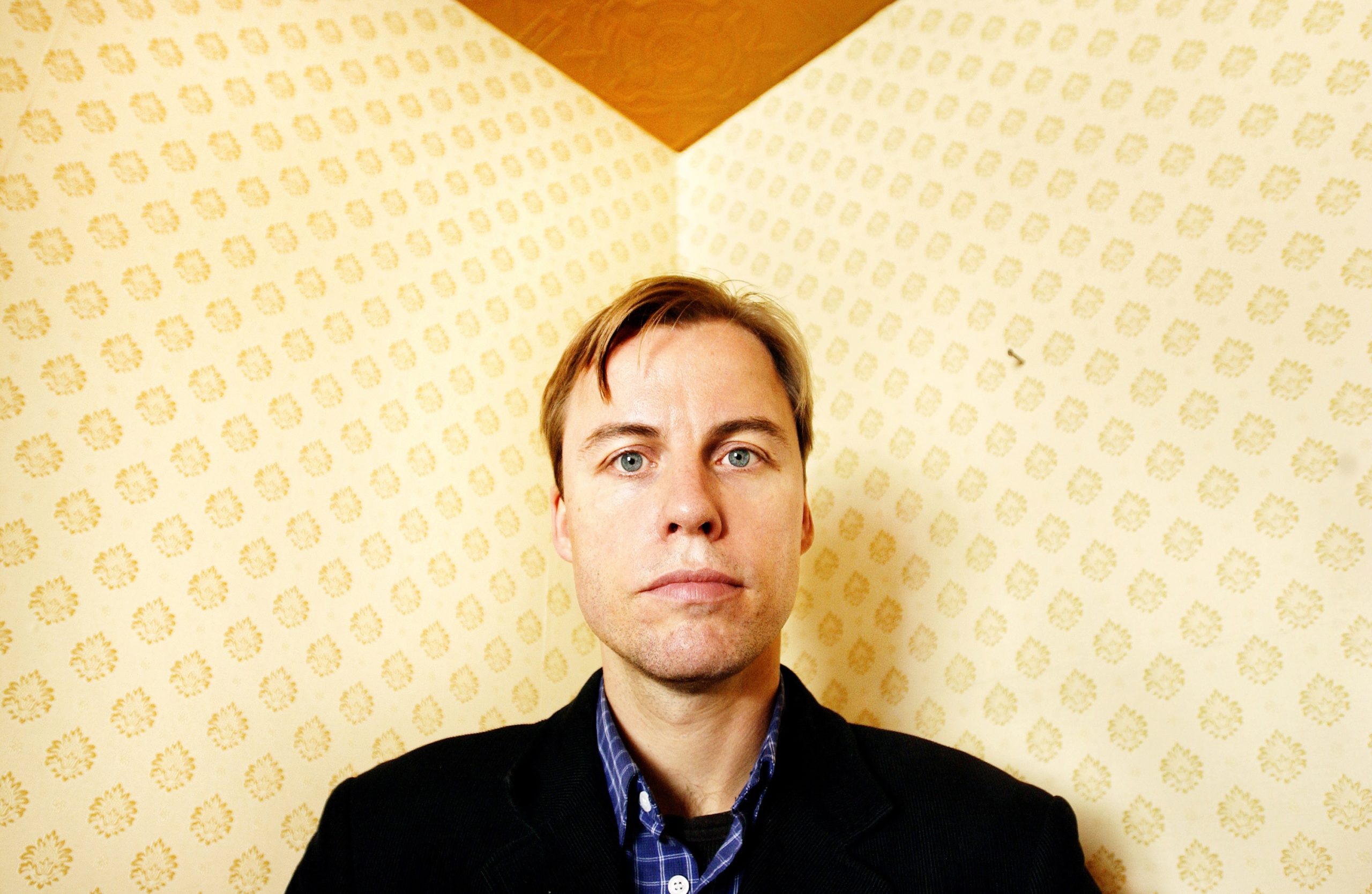
For years, I have a dreamed of a room in which people can die in peace. It’s a simple room: flooded with light, with a wooden floor. It is a copy of a room I once saw at the Museum Haus Lange-Haus Esters in Krefeld, Germany; a marvellous piece of classically modern architecture that concentrates on the basics. I have recreated this room – as an artist, that is what I do – and at the moment, it is standing right here in my studio. Any minute it could be dismantled, put on a plane and reinstalled anywhere in the world, for someone nearing the end of their days and who wants to die in a humane and harmonious environment.
I’m not a naive person, but I don’t think there is anything wrong or perverse about this dream. I think it’s quite innocent. So it has been rather a shock to me that for the last week I have been receiving death threats by phone and email.
It started at the beginning of the week, when I mentioned my project about death and dying in an interview with a reporter from the Art Newspaper. I didn’t think much of it, as I have talked to curators about this at length since 1996, and there have been several mentions in exhibition catalogues.
The reporter was very interested and wrote an article about it. Two sentences from this article have been quoted repeatedly: “I want to display a person dying naturally in the piece or somebody who has just died. My aim is to show the beauty of death.”
I did say those things, and I still mean them. Of course I expected reactions. But I didn’t expect that quite so many publications would quote me without putting the statements into context. Within a few days, thousands of articles appeared across the world relying only on these two soundbites. In a way, I am not surprised that they have triggered some absolutely horrific images in the heads of journalists and readers. And yet I am still astonished by the nature of the comments I received, and disturbed by their vulgarity and violence. I received threats in multiple languages, some of them absurd, some of them seriously threatening.
____
Show
________________

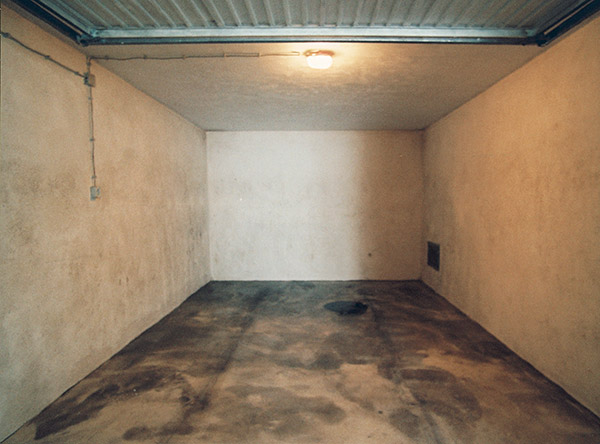
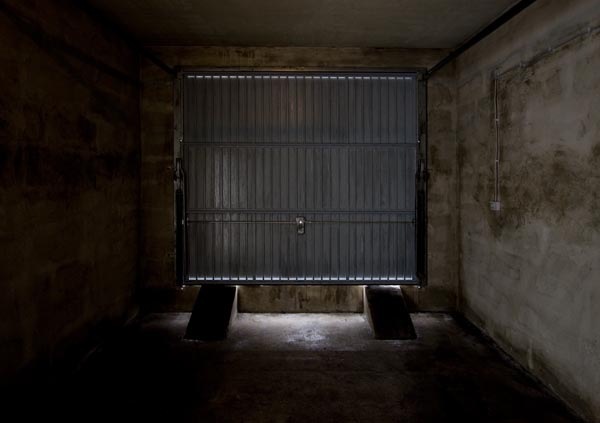
Doppelgarage (2003)
‘At the very least, the artistic shaping of Gregor Schneider’s rooms, and his “double garage” in this case, is influenced by literary or cinematic models. It is evident that his system emerged in relation to room elements through which he knows how to convey his intentions with the artistic details of a sculptor, even if this involves virtually ready-made rooms. This distinguishes Schneider from Mike Nelson and Christoph Büchel, the two other room- installation artists who draw from literary and cinematic sources. Nelson is influenced, for example, by Jorge Luis Borges and the science fiction writer J.G. Ballard, while Büchel’s rooms are often politically motivated and, with his stacks of flea market goods and waste, frequently resemble pop-assemblage.
‘Gregor Schneider is a visionary in the minimalist and post-minimalist tradition in a completely different sense. Although he is associated with the museum world and the white cube of the exhibition hall, the “beauty” of his cold room organisms is independent of their aesthetics, something more reminiscent of Bataille’s The Tears of Eros. Schneider works different figures into his concept of beauty, such as the ghost of John Fare, who was said to have amputated parts of his body during performances, followed closely by Kafka’s tattoo machine and the Comte de Lautréamont’s demonic creature mentioned in Maldoror. Therefore, it is also evident that Gregor Schneider not only organises rooms, but also wants to make death beautiful again.’ — Zoe McCloskey
__________________



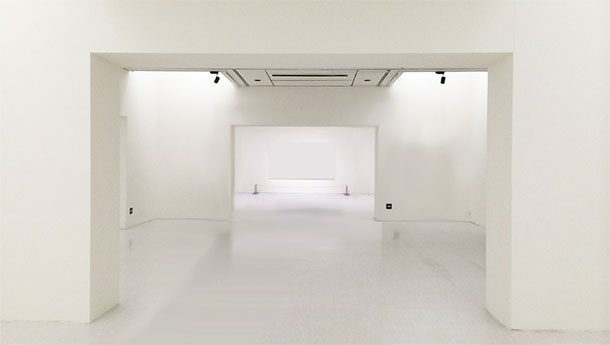
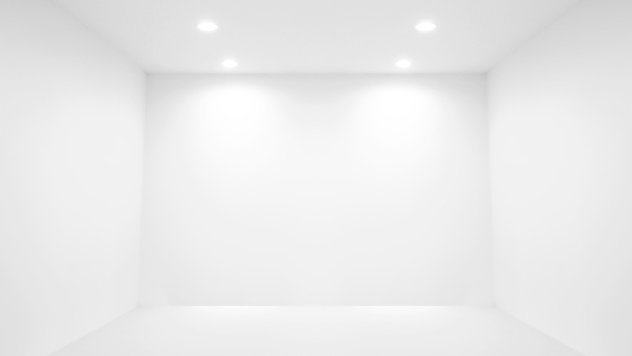
White Torture (2007)
‘One has hardly entered the complex of passages and rooms and already one has lost one’s bearings. One of the doors opens up onto a second passage with sliding doors once again to the left and right. This time one comes upon a dark room, sound-proofed and light-proofed with black foam plastic elements. When the door closes behind the visitor, it gets so dark that one can no longer see one’s hand before one’s eyes. There isn’t even an emergency light. One cannot enter this room without an immediate feeling of anxiety. One feels one’s way along the wall like an insect, in the hope of finding an exit. At the same time one struggles against panic attacks in the hope of regaining some orientation. There are two exits, but these again only lead to further passage-ways. More rooms containing more horrors align them.
‘What is so jarring about Schneider’s installations is that the museum and prison building are indistinguishable from each other. Of course, this is only a mock-up of a prison, a mini-prison with perhaps twenty cells and four passages, but it is quite enough to give one an idea of how hells can be made. One does not have the feeling of entering a model, but rather of being shunted through a real prison, although one in fact knows better and is holding one’s entry ticket in one’s hand, after all. It is more than a mere model situation and less than a genuine prison. It is an artificially created terror that shows that hell can be made and that a couple of clinically white rooms are enough to break a human being. Weiße Folter (i. e. White Torture) is what Gregor Schneider has termed his exhibition. He is alluding here to torture techniques that aim at breaking a person without causing him or her external harm.’ — Goethe Institut
__________________
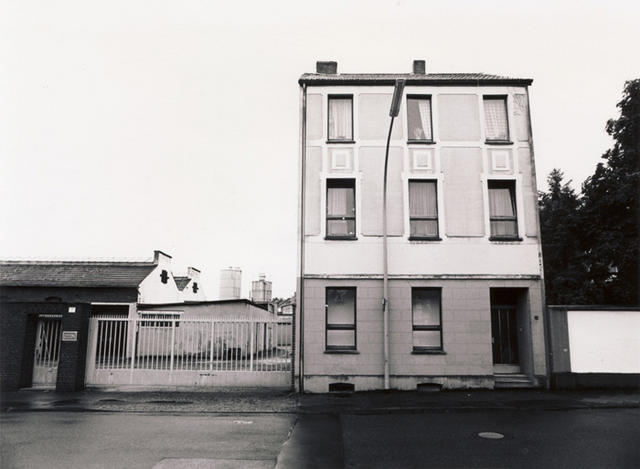
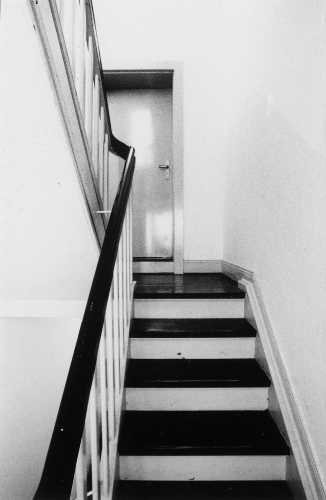
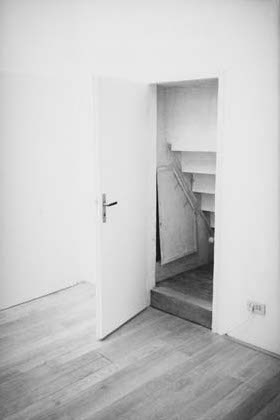

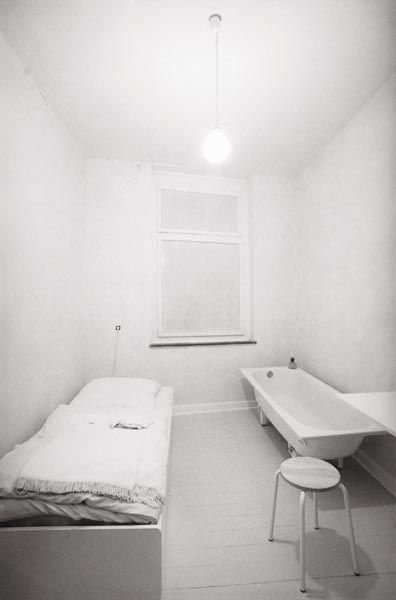
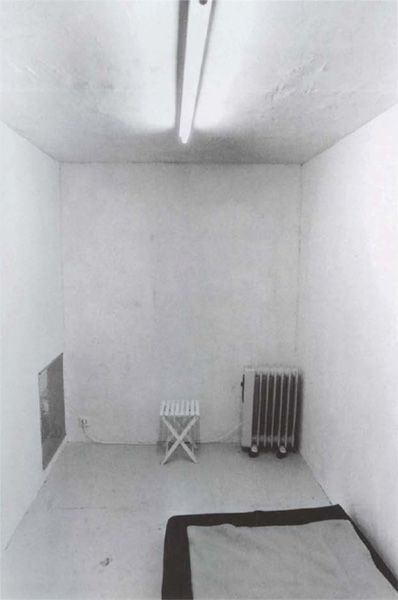
Totes Haus ur (2001)
‘Like the psyche as multiple dwellings imagined by the great Russian theatre theorist Constantin Stanislavski, the Totes Haus ur is actually several houses. It is made from parts of the Haus ur (begun in 1985) — which is both Schneider’s home in Rheydt, Germany, and his major piece as an artist—and is also an autonomous work. It contains multiple houses within itself that register Schneider’s ongoing project of reconstructing the interior of the house; his own description of the project reads, in part: “wall in front of wall, wall in front of wall, wall behind wall, passage in room, room in room.” Unlike the orderly psyche described by Stanislavski, in which everything is easy to find until the last crucial moment, this labyrinthine environment felt like a particularly difficult place in which to locate the elusive bead, as if it were an architectural representation of a psyche so turned in on itself that the journey into it leads to dead ends, hazards, and conundrums like windows that open only onto other windows and rooms bathed in light that appears natural but is actually artificial. Or perhaps the Totes Haus ur is not so much the site of a quest as the product of a restless search that involves ripping out, moving, and rebuilding walls, doors, and whole rooms in the hope of finding or creating the place into which the invaluable bead disappeared.’ — PAJ: A Journal of Performance and Art
____________________


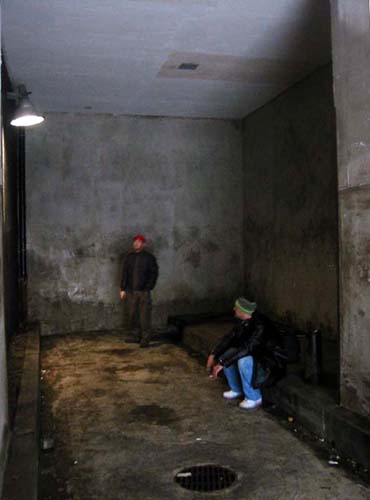
517 West 24th (2003)
‘517 West 24th, as it’s titled, cuts a 15-foot-wide and 45-foot-long blunted L-shaped channel from the sidewalk into the Barbara Gladstone Gallery space in NYC. It is accessible 24 hours a day under a partially pulled-down metal gate (at night, a guard is on duty nearby). From the outside, this hole-in-the-wall, which used to be the inside of the gallery and technically still is, resembles a moldy loading dock. A sidewalk and a craggy floor have been fashioned out of cement. The walls have been shellacked in scum and covered in grimy blotches. There are oil stains, air ducts, drainpipes, a post, open sewer, industrial light and chunks of crumbling debris.
‘Kafka wrote, “Everyone carries a room about inside him”; Guston made note of “a forgotten place of beings and things.” It’s wonderful and unexpected to see one of these rooms and some of these things out in the open. Schneider’s schizy love and fear of space prevent 517 West 24th from being merely trompe l’oeil and allow it to touch on issues of history, economics, philosophy and sex. This, combined with his own hyper-sensitive, almost drugged-out ability to invest material with anxiety, suggests that for Schneider, space is a living thing to be handled, inhabited and annihilated.’ — artnet.com
_______________
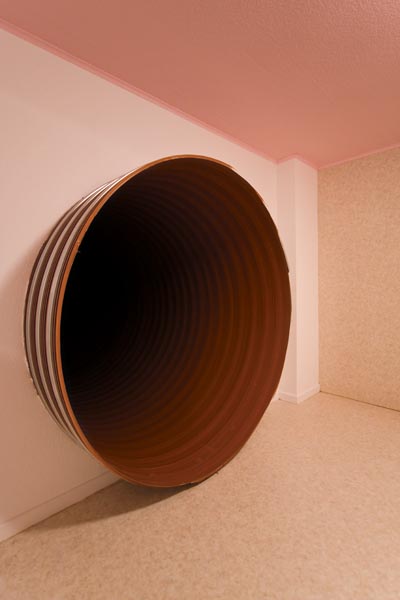


Dead End (2012)
‘Dead End gives the impression of being an endless intestinal system, a system that follows its own inexorable logic and laws that lie at the margin of traditional museum architecture. Its critical strength lies in its dynamics, which flow out of the impulsion to move ceaselessly forward. Literature abounds with examples of systems of interminable tunnels and caves such as the tale of the caverns in Jules Verne’s A Journey to the Centre of the Earth and the short story The Tree on the Hill by H. P. Lovecraft. The cinema provides a catalogue of works that express the same tension, some best examples being Alien (Ridley Scott, 1979) and The Descent (Neil Marshall, 2005). However, whereas a film is mere fiction, art plays a role in our reality through its presence in physical space.
‘We find ourselves in a tubular passage whose true function has been subverted, trapped one might say, in the abstraction of its form. The form that Gregor Schneider gives to his spaces and passageways owes little to the influence of literature or cinema. As we have seen, Schneider’s modus operandi arises from the union of real elements in space through which he knowingly transmits his artistic intentions in sculptural form, although these works can be considered to verge on ready-made spaces.’ — Centre de Arte Dos de Mayo
_________________
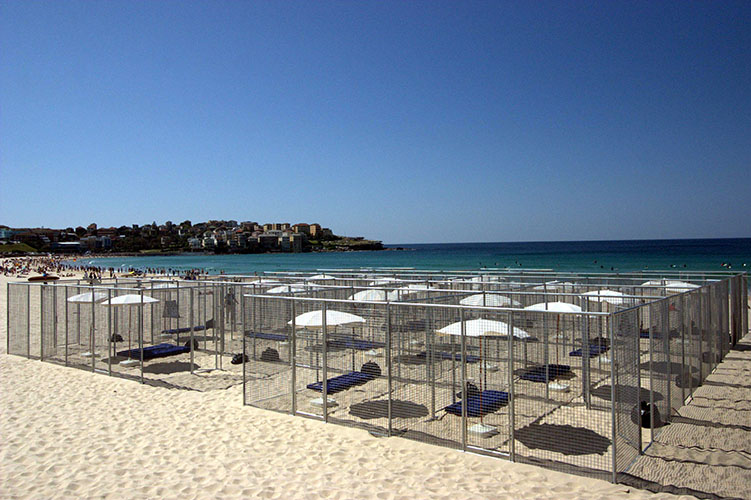
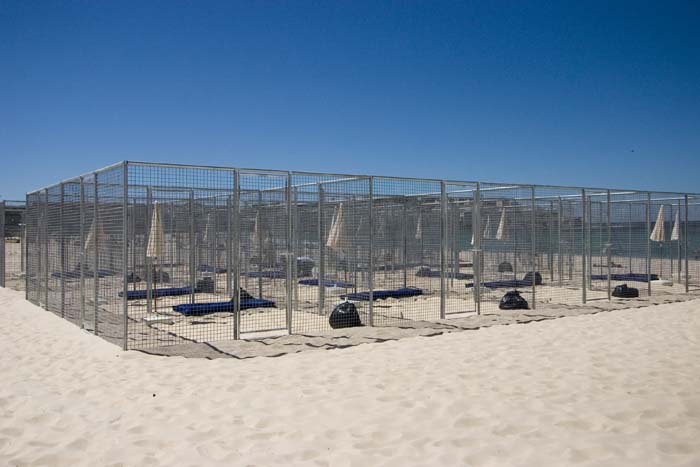
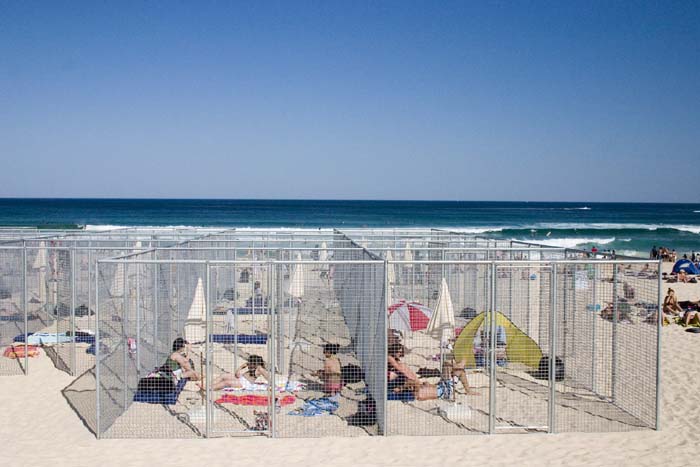
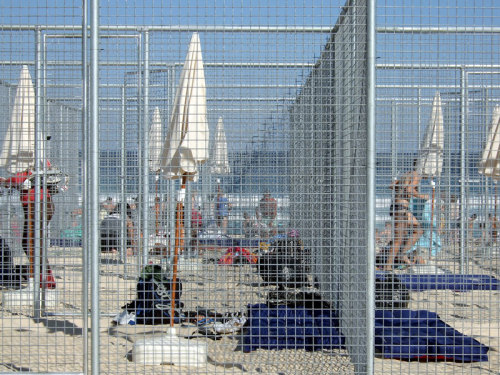
21 beach cells (2007)
‘Gregor Schneider transformed Sydney’s iconic Bondi Beach in 2007 with a giant cage titled 21 beach cells. The 4 x 4 metre cells contained amenities for visitors – an air mattress, beach umbrella and black plastic garbage bag – and were soon inhabited by beachgoers looking for a site to rest and find shelter from the sun. The shadow image of Guantánamo Bay’s Camp X-Ray – and Australia’s own immigration detention centres – became a site for relaxation. 21 beach cells captured the atmosphere of the time, an environment of global terrorism, detention of illegal immigrants and the recent Cronulla race riots, questioning Australia’s egalitarian self-image.
‘The indeterminate purpose and function of the 21 beach cells positioned them between comfort and isolation, safety and imprisonment. The work’s labyrinthine structure became apparent once people were inside. The transparent walls gave a false impression of expanded vision and orientation. Some doors were locked and required visitors to retrace their steps to the exit; others led into open cells, creating confusing paths and passageways. Schneider stated that the influence for the work was the Cronulla race riots, which occurred on 11 December 2005 when a crowd of around 5000 young Anglo-Australians descended on the Sydney suburb to ‘reclaim the beach’, leading to violent attacks on people of Middle Eastern appearance. A backlash from the Lebanese community resulted in a pervasive environment of fear and segregation, including a police ‘lock-down’ of the local area.’ — Kaldor Public Art Projects
_________________

END (2008)
‘With his project for Germany’s Museum Abteiberg, artist Gregor Scheider literalizes the harrowing experience of seeking enlightenment. Schneider’s known for exposing the shifting psychological (and often disturbing) undercurrents that run through our personal spaces (Haus Ur and Die Familie, I’m talking about you). With END, Schneider takes on a public institution we look to to learn about ourselves. The 2008 piece was a new entrance to the museum: a huge, black, Suprematist square of an opening, followed by 70-meters of absolute darkness, the tunnel tapering to a 1×1 metre opening of light.’ — Museum Design Lab
—-
*
p.s. Hey. ** David Ehrenstein, Hi. It was the actual link that didn’t work, i.e. the pressure point wasn’t functioning. Thanks for the replacement. And thank for setting me up with the Randy Newman interview! Everyone, Mr. Ehrenstein’s big, big sale is still extant. David: ‘Dear Friends, Xmas is over but my humungous emergency sale of DVDs, CDs, LPs and books at bargain prices has goes on. The sale also includes a beautiful gold-plate framed mirror (a steal at $100.00. I can be met in person at the address below 24/7. Please call come on over and shop til you drop, or you can do it all by mail (except for the mirror). I need to sell at least $100 worth of stuff by Monday’. The aforementioned address didn’t make it into his comment, but you can get in touch with him by email at cllrdr@ehrensteinland.com. ** Tosh Berman, My great pleasure, Tosh! Is TamTam still ongoing? It’s been a while since a TamTam book was published, or am I spacing out? ** Steve Erickson, I hate the NYC subway system, but I’d more than settle were it temporarily transplanted in Paris at the moment. I need to see ’63 Up’. I’ve seen all the forerunners. Everyone, Steve has reviewed the latest instalment in Michael Apted’s legendarily infinite film project ‘ … Up’, this time ’63 Up’. Read what he thinks here. Interesting to read your and David’s back and forth about Varda/Demy. ** _Black_Acrylic, If you’re an SG fan, I’m positive you’ll be rolling around in clover when you read the bio. I agree with you about that 33 1/3 book, yes. ** Okay. My galerie has a Gregor Schneider show today. If you don’t know his stuff, you’re in for some eerie, intelligent fun. Check things out. See you tomorrow.




 Now available in North America
Now available in North America 
This was the first thing I read on waking up today and it makes me so happy. Schneider has been my absolute favourite ever since I first read about Totes Haus ur. I used to stay up all night watching all the long, low resolution video tours of those terrifying rooms. It was around the time I read ‘House of Leaves’, and my obsession with houses as psychological spaces concealing layers of horror has persisted. Schneider did a performative piece in London in the mid 00s called ‘Die Familie Schneider’ where he rented 2 identical, neighbouring terraced houses and installed 2 ‘families’ made up of identical twins, one set in each house. You would book 30mins in the houses and walk around alone observing each identical family acting out times rituals or staring at the walls or hunched over and sobbing in the shower. In each bedroom was a body in a black plastic bag, moving slightly. It sounded beautiful and absolutely terrifying. Sadly there were limited time slots and I missed out.
Tbh I don’t think a day has gone past in the last 15 years where I haven’t thought about Schneider’s work.
As I just said on FB – my fav writer covering my fav artist, happy fucking 2020 to me <3333
– Sailor
Oh dear I’m not sure if my comment posted, going to try again -__- my phone has been glitchy since my friend dropped it in a glass of water on NYE…
This was the first thing I read on waking up today and it makes me so happy. Schneider has been my absolute favourite ever since I first read about Totes Haus ur. I used to stay up all night watching all the long, low resolution video tours of those terrifying rooms. It was around the time I read ‘House of Leaves’, and my obsession with houses as psychological spaces concealing layers of horror has persisted. Schneider did a performative piece in London in the mid 00s called ‘Die Familie Schneider’ where he rented 2 identical, neighbouring terraced houses and installed 2 ‘families’ made up of identical twins, one set in each house. You would book 30mins in the houses and walk around alone observing each identical family acting out times rituals or staring at the walls or hunched over and sobbing in the shower. In each bedroom was a body in a black plastic bag, moving slightly. It sounded beautiful and absolutely terrifying. Sadly there were limited time slots and I missed out.
Tbh I don’t think a day has gone past in the last 15 years where I haven’t thought about Schneider’s work.
As I just said on FB – my fav writer covering my fav artist, happy fucking 2020 to me <3333
– Sailor
Odd body of work today, Dennis. I’m itching for a walk-through. Will look out for Schneider’s work in the future.
Greetings from Taipei. I have to say this place just keeps getting more impressive. Apparently there’s a decent local experimental music label with a shop that I’ll check out soon. And there’s a noise gig tomorrow night, in some mysterious location that I will try to locate. Did I mention the tasty and cheap local street food? And the recently exploding craft beer scene? Off to get some inscrutable dessert, once I decide on one of several irresistible options.
Bill
Spooky Stuff Today. Those “beach Cells” remind me of the cages Trump’s racist (yet Jewish) “advisor” Stepehn Miller created for Third World Latino children separated from their families at the border and sold into slavery in the U.S.
Gregor Schneider’s work is very effective and strong. I’m very sensitive to space and seeing these images brings emotional, and sometimes phobic reactions from yours truly. The beach cages are so sinister. And the room with the bed and bathtub is superb.
TamTam Books is on hold at the moment. I won’t be doing any more translations, because it is so expensive for me to produce. Also, I feel I did everything I wanted with the press. I look at TamTam Books as a circle. From the beginning, I did the Guy Debord book, which mentions the Jacques Mesrine memoir, and that was my last release of the French translations – and therefore I completed that circle, with the Vian and Gainsbourg titles. Doing the Sparks Lyrics and Lun*na’s (Menoh) book were projects outside that circle, but very satisfying to me. So, if I do go back to publishing, it will be projects started from ground zero to completion. Mostly now, I want to focus on my writings. The whole experience of my memoir is great. Dealing with City Lights, the public, the readings, my small tour – all of it is fantastic. I’m very fortunate. Now, catching that bit of lightning in a jar is going to be difficult, but that remains to be seen.
Marvelous, check out Rudolf Schwarzkogler ,
Important to know that John Fare is an Urban Legend…
About Gregor Scheider, I wonder if he is aware of :
https://www.history.com/.amp/topics/crime/murder-castle#aoh=15780694502145&_ct=1578069477886&referrer=https%3A%2F%2Fwww.google.com&_tf=From%20%251%24s
Hey Coopster!
Happy new year my friend!
I am not prone to making portentous pronouncements in the first days of the year, nor any resolutions other than ‘try and get out of bed at least 365 times’ – wait 366! – but anyway, I do hope it’s a good one for you, with goodness galore!
Did you have a good xmas and eat the bûche? We had not one but TWO xmas dinners and basically just spent 2 weeks reading books, hanging out with friends and family and eating lavish food, so it was all very nice and civilized. I got an Ivy Compton-Burnett book as a present, inspired by your blog suggestion a little while back, and am reading it right now with sardonic mirth, as I believe one should.
Hugs and bon mots!
I haven’t seen JANE B BY AGNES V and won’t be able to catch it in Lincoln Center’s current Varda retrospective (which ends Monday), but I know that the idea for KUNG-FU MASTER originated there.
My eyesight has deteriorated a lot over the past 6 months. I’m starting to get really frightened. I must have mentioned my diagnosis of cataracts here, but if that’s the sole cause, I will need to get surgery for them within the first half of this year. I saw an ophthalmologist twice last fall, but I am gonna see him again next Wednesday to see if I can figure out what’s going on.
Dennis, So Variosos and Galeries are my faves, as you know, and they never disappoint!
Here’s a weird fucking story about my going to see the new Star Wars with my friend and her 10-year-old son:
It was Dolby Digital, loud as hell, with big reclining seats that rumble. About halfway through the movie, this guy two seats to my left (we had an empty seat between us) yells out really loud. I look over. He says, “Oh, I’m not talking to you.” A minute later, he gets up in a huff and runs out of the theater. We didn’t even have time to put our feet down; he just pushed through.
He comes back five minutes later with the manager. Kind of points in my direction and goes to his seat. The manager sits in the empty seat between us, leans in toward me, and goes, “We have a guest complaint that you’re breathing too loud.”
“Breathing too loud?” I’m incredulous, of course.
The manager kind of shrugs and nods.
“I have no idea what you’re talking about.”
He turns and says something to the guy and then gets up and leaves. Here he comes five minutes later. Of course, I’m getting pissed, thinking he’s going to ask me to move or leave or something. He didn’t, thank God. He did sit down in that empty seat again and we could see him offering the guy the chance to move. The guy declined.
After the movie, the guy and his girlfriend just kept looking straight ahead and wouldn’t look at us. Which was cool. I didn’t need to get into it with this guy.
What’s funny is that my friend’s son had leaned over and asked me what was going on (he was sitting next to me on my right), and I had told him in his ear. After the movie, he was like, “I didn’t believe you. I was sitting right next to you and I didn’t hear you breathing!” My friend had two women sitting next to her who talked during the movie, but she said she couldn’t hear them, could only see their lips moving. It was that loud in there. But I was breathing too loud? Get the fuck out of here.
Anyway, yeah, kind of a weird, funny, only-George start to the new year.
Oh, and LPS…yeah, we’re trying. As usual. But it’s to no avail so far. As usual. Says we need to get him a car so he can work. And wants a Playstation 4 after having sold his other one and his Xbox One for weed money. Fuck that. Oh, and after all I spent on him for Christmas and his birthday. But we’ll keep trying with him.
Take Care Steve!
Latest FaBlog: Wag
Oh wow, being able to have seen ‘The End’ sounds even more amazing! Thankfully, it’s been preserved on YouTube so I’ve watched it there. I found the way it mixes mediums very powerful so I can only imagine the added effect of experiencing it live and with others. “Never a fully happy task.” sums up looking for work perfectly haha. I didn’t have any special plans for New Year’s, stayed home and celebrated with friends for the most part which was pleasant. Did you end up seeing any fireworks?